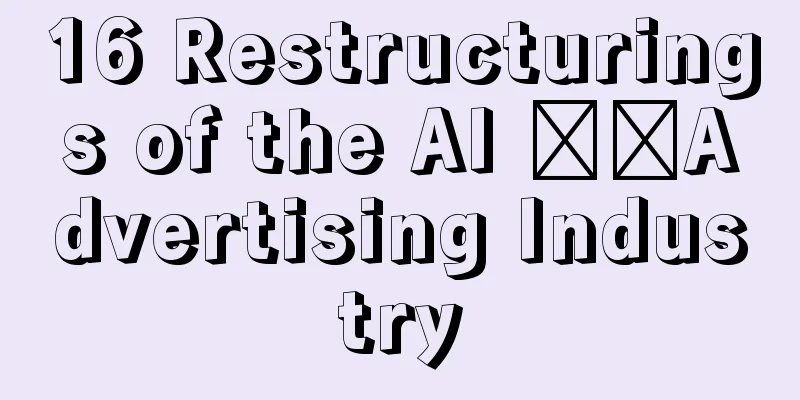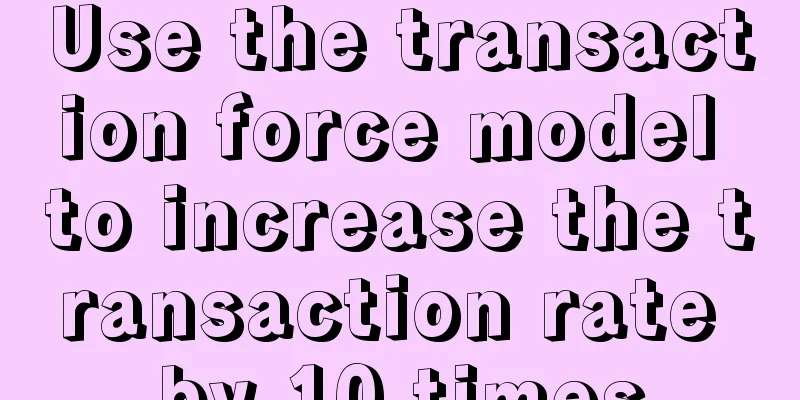16 Restructurings of the AI Advertising Industry

AI is not a trend, AI is a revolution. In terms of advertising, this trend has already arrived. Overseas, Meta, the parent company of FaceBook, is accelerating the process of generative AI advertising. Many platforms, including Hour One AI, Synthesia, Synthesys, and Pictory, are entering the industry. Without any code, only conversational interaction, marketing effects can be quickly generated. This new advertising production model is subtly subverting the entire industry. According to Accenture's forecast, 30% of social media ads will be automatically generated by AI by 2029. What disruptive changes will it bring? How will it drive business innovation? What transaction logic will it refresh? As usual, Party A Finance has compiled some online opinions and added some super brainstorming ideas, hoping to bring inspiration to practitioners, and you welcome sharing and discussion. An era and industry that changes every five years1) How to define AI advertising All AI methods used in the process from insight output to activation of optimized advertising, including artificial intelligence-related technologies and algorithms such as machine learning, neural networks, computer vision, natural language processing (NLP) and intelligent process automation. 2) Three layers of AIGC: basic layer, middle layer and application layer The basic layer is mainly composed of pre-trained model technology investment, and representative companies include Open AI and Stability.ai; the middle layer provides vertical, scenario-based and personalized models and application tools; and the application layer provides text, picture, audio and video and other content generation services for B/C users. 3) Four main parts of the advertising industry: technology, creativity, media, and operations AD Network optimizes technology and media, DSP/ADX further optimizes media, oCPX optimizes operators, and AI has the potential to reconstruct all links with a revolutionary impact. 4) AI advertising is not new In fact, as early as 2020, Jasper began to empower creators to create advertisements on FACEBOOK, comprehensively improving operational capabilities to find new creative marketing breakthroughs. The question is: What level of energy is driving AI’s transformation of the advertising industry; which links will this transformation directly and indirectly change; in which scenarios will the new wave of technological dividends appear; and what are the unknown risks and disasters? Below is the main text, 16 predictions for the restructuring of the advertising industry within five years. 1. Reconstruction of production and creationThe scale and sophistication of modern digital business inevitably requires a shift from human experience-based decision-making to machine intelligence-based decision-making. The explosion of generative AI has been initially realized in the field of copywriting materials. Advertisers only need to provide relevant keywords and themes, and AI can automatically generate corresponding copywriting. AI writing technology can analyze the tastes and needs of the audience, optimize the language of copywriting to make it closer to the audience, and achieve one-to-one personalization in batches, thereby improving advertising effectiveness. At present, the focus is still on the field of literary and artistic creation, and AI generation of images and videos is still in its early stages in the field of advertising. In the future, AI will be able to customize product features based on customers’ values and match their ideas. From having thousands of faces for thousands of people in the past to having billions of faces for billions of people in the future, it will be just around the corner in 5-10 years. 1. AI will produce a massive amount of mediocre ads (95%)Advertisements produced by AI appear to be quite standard, based on a hard framework that does not lead to common sense errors, but they actually lack key humanistic elements such as humor, empathy, and cultural context. Currently, we are still in the early and barbaric stages, focusing more on quantity than quality. Therefore, we will most likely see a large amount of AI-generated content rushing to the Internet. They are not perfect, and may even experience a reverse cycle of the AI Uncanny Valley. Directly using AI to generate advertisements and deploying them on a large scale in advertising marketing still carries great risks and still requires manual screening and experience-based judgment. 2. Reconstruction of Interaction1. Conversational transaction-oriented customer service digital humans become standard (80%)The so-called intelligent customer service in the past was actually not intelligent at all. It was still based on template logic, unable to truly understand consumer needs, and lacked the human touch in real consumption scenarios. After the full implementation of AI, these three points will be integrated together to form a complete solution: First, ChatGPT-like technology can natively understand the real needs of consumers and have the ability to have instant conversations; second, the digital person based on the sales champion of the main investment entity, in addition to having a real-life appearance, also simulates the subjective consciousness and sales experience of the transaction scenario, and communicates with customers in a real way to force orders; third, it is transaction-oriented, greatly improving the transaction rate and conversion rate of this link. 2. Proactively understand customers, and the relationship between brands and consumers is closer (50%)With authorization granted, pre-sales AI robots will appear to collect consumer preference data in the customer's social network in advance, form a predictive model, complete the screening process in a shorter time, and provide content creation in a style that is close to the user's favorite based on the differences in preferences of the target groups, so as to improve the conversion efficiency of content marketing itself. By understanding customers proactively, continuously, and in multiple dimensions, brands and consumers may become friends that go beyond transactions. 3. Real-time linkage between virtual and physical ad spaces (55%)Mobile phones and computers are just one of the advertising media. With the further popularization of low-cost screens and the evolution of VR, AR, MR, and XR, online scenes, office scenes, elevator scenes, outdoor scenes, etc., a virtual-real super network is formed. Advertisements are also connected seamlessly everywhere along this super network, and all platforms are linked. 3. Reconstruction of payment model1. There is a crisis in users’ trust in advertising (35%)Where there is a spear, there must be a shield; where there is attack, there must be defense. Online and offline, there are massive amounts of AI-generated advertisements, AI customer service robots, and AI transaction interactions. When a threshold is reached, consumers become immune to or even distrust AI advertisements, which requires a thorough reconstruction of trust. We believe that there will be many possibilities to solve the problem: such as trust enhancement through AI+blockchain, full-chain information disclosure, etc., to achieve transparency in the entire marketing communication process. Of course, there is also a possibility that a certain group of people will only accept real-person advertising. 2. CPV becomes the main payment model (70%)True “advertising is transaction”. In the past, CPC, CPM, CPL, CPA and other models will be relegated to auxiliary roles, and CPS will become the main payment model, charged according to final sales volume, to achieve true performance advertising. The CPS settlement cycle here will be extended to more accurately calculate the comprehensive weighted index of each advertisement on consumer decisions, especially delayed purchases and low-frequency large-scale consumption. This means that a new AI-based advertising value measurement system is needed, and the CPV (Value) model may be more appropriate. Therefore, there is also a chance that dynamic ROI based on lifetime customer value will emerge. 3. Infinitely approaching the C2M customized marketing closed loop (65%)In traditional methods, advertising is mainly done by labeling to select groups of people. However, with the help of AI technology in the future, it will be possible to more accurately target audiences and achieve truly personalized display for each individual, thereby improving consumers' advertising experience and advertising effects and achieving more detailed advertising presentation. Moreover, AI can help enterprises customize and generate a closed marketing loop, including creative production, precise targeting, intelligent optimization, deep conversion, lead management and other links, and support a professional service system for multiple business models. 4. Real-time dynamic adjustment within minutes (70%)AIGC can also play an important role in monitoring and optimizing advertising effectiveness. By analyzing and providing feedback on advertising effectiveness data, it can make real-time adjustments to advertising, thereby improving the effectiveness and ROI of advertising. From adjusting strategies based on daily and weekly data to automatic dynamic adjustments at the minute level through AI, this will gradually become a reality. The Wanamaker Conundrum in the Advertising Circle: "I know that half of my advertising dollars are wasted, but I don't know which half." This sentence should be changed to: "I know my advertising money is wasted, but it is only a dollar at most." 4. Reconstruction of practitioners1. 90% of low-level entry-level jobs will disappear (90%)The changes that AI has brought to the advertising industry are faster and more dramatic than expected, and advertising practitioners have become one of the jobs most easily replaced. AIGC mainly solves two problems. The first is what humans cannot do, such as the collection, aggregation, and induction of data on a larger scale; the second is what humans are unwilling to do, such as some mechanized behaviors. In the next five years, very basic design and copywriting will be replaced by higher-level AI models, and copywriters, designers, illustrators and even strategists will not be spared. On April 13, BlueFocus released an internal email, announcing that AIGC has the potential to replace more jobs, which means that a large number of employees will face the risk of unemployment. AI will not eliminate everyone, it will only eliminate those who cannot use AI tools. 2. Create high-dimensional strategy positions (35%)The AI that can be foreseen at present cannot possess the core of emotion and empathy like humans. In the entire advertising production chain, there are three types of strategies that still rely on human wisdom: advertising strategies for more vertically segmented scenarios and populations (relying on high-threshold knowledge and experience reserves), review strategies based on laws, regulations, and public order and good customs, and rule strategies after problems and disputes arise. An advertising strategist may be able to manage and coordinate advertising that affects hundreds of millions of dollars, and the value leverage of people in certain positions will be infinitely magnified. 5. Reconstruction of legal supervision1. AI advertising labeling + manual review become standard (75%)In the AI era, there will be a new AI privacy protection mechanism that will blur the user's traces at a single touch point, perform desensitization processing, and strengthen the protection of personal information. The advertising industry is one of the main regulated industries. The "Internet Information Service Algorithm Management Regulations" also stipulates user data and algorithms, requiring the protection of users' right to know and choose algorithms, and imposes some restrictions on advertising companies' access to user data. AI advertising identification and manual review are launched, and these two are likely to be necessary. 2. AI regulation of AI (50%)In the future, AI compliance will still have to rely on AI technology itself to form an adversarial model of AI supervision of AI, such as AI real-time detection platform, AI real-time review, AI punishment mechanism, etc., and the mutual constraints will be greater at that time. The only thing that can defeat magic is magic. Use your spear as your shield. 6. Reconstruction of the business landscape1. Large vertical advertising models will emerge (85%)It is still the main battlefield of the giants, such as Tencent Advertising, Bytedance, Alimama, Baidu Marketing and other platforms. As the comprehensive big model of the parent company is improved, the big model of vertical advertising will naturally emerge and become a new competitive barrier. The technological evolution centered on big advertising models is happening at a speed beyond our imagination. The construction of big models has promoted the rapid progress of machine learning platforms, and the two have formed a virtuous spiral. In fact, DTABs are already working on it and have a lot of publicly available materials. After all, advertising is an important commercialization model for each company. 2. Massive advertising data will be an initial barrier (70%)The more data, the better; the bigger the model, the better. The feature scale of large advertising models is as high as hundreds of billions. To provide training for AI models with ultra-large-scale parameters, a massive amount of original advertising data is needed to improve calculation accuracy, make cold starts faster, reduce idle waste, and optimize deep conversion goals. Therefore, high-quality content digital assets are the winning point of generative AI. It is difficult for traditional AI companies to possess data in this area, and it is also a unique advantage of advertising platforms. At the same time, customers’ demand for refined growth is also crucial to the evolution and development of the advertising big model. 3. The importance of media is inspiring (65%)Even though AI is in vogue, as the strongest channel in offline physical space, the importance of ladder media has not decreased but increased, and the closer it is to the real world, the scarcer it is. Empowered by technologies such as AI and 5G, in addition to upgrading and integrating their own technologies, online media and online media will also become an important part of the future AI advertising linkage. All technological progress is good for NVIDIA; All business models are good for Moutai; All advertising changes are beneficial to Focus Media. 7. ThinkingThe emergence of AIGC represents the use of AI algorithms and large models to rearrange and index information, and also represents the emergence of a better way of advertising interaction. The combination of the two will definitely be a genetic mutation in the trillion-dollar advertising industry. GroupM Global released the "Next Decade: Artificial Intelligence" report, which for the first time predicted the scale of artificial intelligence in the advertising industry. "In 2022, global AI advertising will exceed $370 billion; in 2032, it will cover the vast majority of media, reaching $1.3 trillion, accounting for more than 90% of total advertising revenue." Embracing AI and giving it love has become the only choice for mankind. Millions of advertisers should not force AI into advertising, but make better advertising in the AI era. References:
Chief Writer: There is a Cow at the Entrance of the Village; Article Architect: Dandan Source: Party A Finance (ID: jiafangcaijing2019). I hope there is no Party A dad in the world who wastes money in vain. |
<<: Whether it’s CPM or CPS, you should talk about brand ROI in the end
>>: ChatGPT continues to be popular, where should AI marketing go?
Recommend
Where can I view Amazon's natural traffic? What are the traffic entrances?
After opening a store on Amazon, merchants need to...
The most searched product, which is flooding the Moments, is the "Sauce Flavor Latte" jointly launched by Luckin Coffee and Moutai.
Have you seen Moutai Latte on your WeChat Moments ...
Is it possible to grow by adding new features? Why not dig for treasures from old features?
Analyze user behavior, identify key features, opti...
Classical method of data analysis: structural analysis
Do you feel that the data we see every day is usel...
With new regulations being released intensively, is video account e-commerce entering a runaway mode?
Video account e-commerce has recently released new...
Do consumers prefer "small favors"? Four keys to help you master the era of cost-effectiveness
Amid economic uncertainty, consumers prefer “small...
With 2.09 million followers in one month, the "ceiling female rapper" on Douyin exploded as soon as she opened her mouth
This article mainly focuses on the Douyin blogger ...
The longest Double Eleven in history has begun. What new benefits can be gained?
This year's Double 11 not only has a longer pe...
Tea beverage brands are flocking to "password marketing", what is the new social code?
This article introduces the case of "password...
How to use the decoration materials for the Shopee Double 11 promotion? How to create a style?
I have just been approved to join Shopee. How can ...
Bloggers anxious about business orders flock to Xiaohongshu to become buyers
As the advertising market gradually tightens, many...
How many points will be deducted from Shopee before the account is frozen? What actions on Shopee will cause points to be deducted?
When opening a store on an e-commerce platform, me...
Who is being upset by Pinduoduo?
The turmoil of the Pinduoduo "store bombing&q...
“Tourism Special Forces” surged during the May Day holiday: 120,000 people “entered Zibo”, but Beijing suburban homestays became unpopular?
During the first May Day holiday after the epidemi...
This Double 11, e-commerce is getting back on track
As the bell of Double 11 rings again, the e-commer...









